This marks the third installment of our Food Lab (nicknamed Shokurabo) series. This project aims to explore food from a slightly broader perspective than usual, under the theme "Considering 'Food and [Subject]'".
This time, the theme is "Food and Loneliness."
Last month, news broke that the UK had created a new position: Minister for Loneliness. According to the report by the UK's Jo Cox Loneliness Commission, the negative impact of loneliness costs the UK economy £32 billion (approximately ¥4.9 trillion) annually.
It seems the problem of loneliness is not unique to Japan.
In Japan, the term "solitary eating" (孤食) started gaining traction around the mid-2000s.
While it previously carried strong negative connotations, recently, as exemplified by "Kodoku no Gourmet" (The Solitary Gourmet), the unique pleasures of eating alone have also begun to be featured.
Japan's society will see a steady increase in single-person households. Furthermore, even within families, individuals increasingly eat meals alone.
In this era of increasing solitary dining, how is it actually perceived? Can we transform solitary dining, which still carries a strong negative impression, into a positive opportunity?
This time, I'd like to explore these questions while examining the act of eating.
Eating alone: "Want to reduce it, but it seems likely to increase"
The "Near Future Mind Survey" introduced in Part 2 of this series.
This survey asked respondents about various food-related items, asking whether they thought each item would "likely increase/decrease" or whether they "wanted to increase/decrease" it in 3-4 years. The results were scored and mapped.
The easiest way to understand it is as a map combining "societal predictions" from consumers with "personal desires."
One of the items surveyed was "eating alone."
Plotting this by gender and age group yields Figure 1.
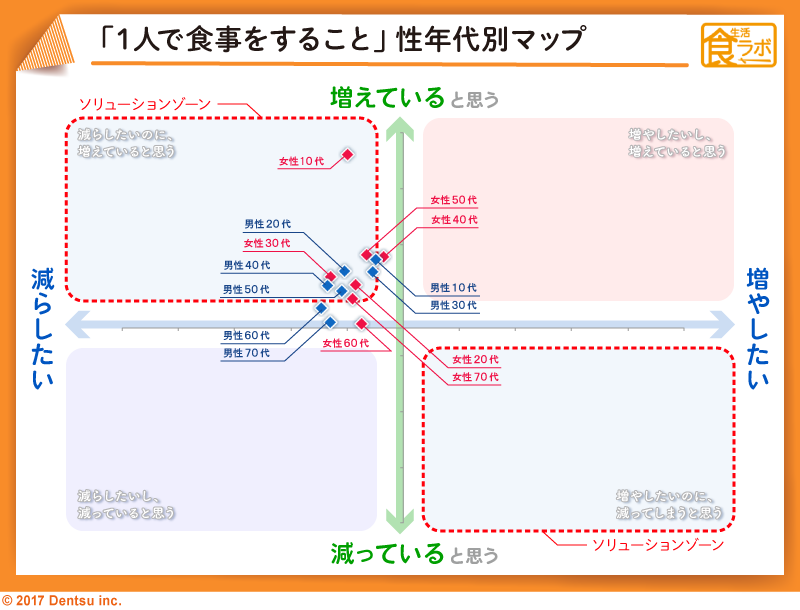
Looking at this, it becomes clear that regardless of gender or age group, "eating alone" is a phenomenon where there is a gap between personal desire and predicted reality—specifically, people want it to decrease but expect it to increase. This indicates it's an area where solutions should be provided.
Particularly distinctive among these are teenage girls, whose prediction that "eating alone" will likely increase stands out.
In Part 2 of our series focusing on teens and unpacking the Near Future Mind Survey, we noted that while teenage girls strongly desire to engage with food proactively, investing time and effort, they feel it's difficult to achieve. We also observed that teens generally have a strong desire to enjoy food with others.
We believe this very sentiment lies behind the prediction we examined this time: "Teenage girls strongly anticipate eating alone more often."
Types of Solo Eating – Shy Type? SOS Type?
So far, we've seen that solitary eating is generally perceived as something people "want to reduce but expect to increase."
But here, a question arises: Do all individuals truly share similar feelings when eating alone? Are the underlying insights behind solitary eating also universal?
The Food Lab survey results※ revealed some interesting findings on this point. The following four graphs show responses to the question about "feelings when eating alone."
※Food Lifestyle Lab Survey vol.5. Online survey (1,200 people aged 15-79, September 2016, conducted by Video Research Ltd.)
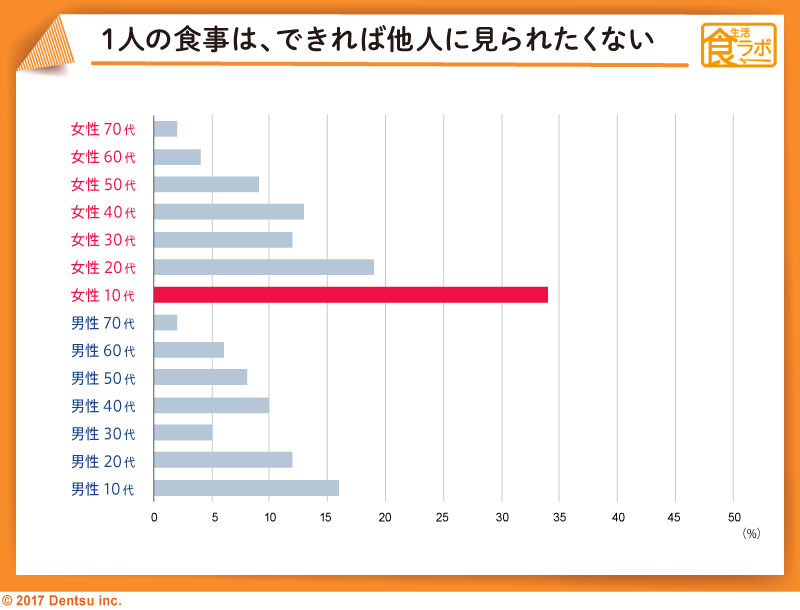
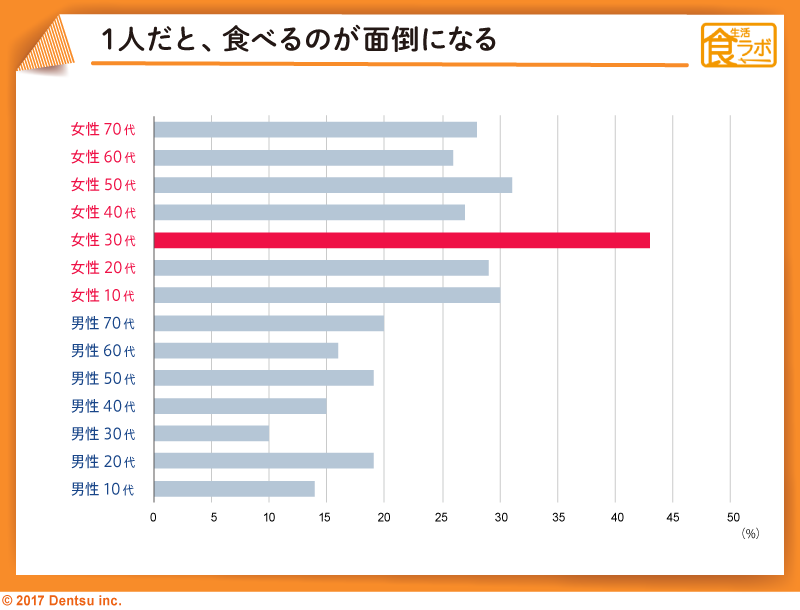
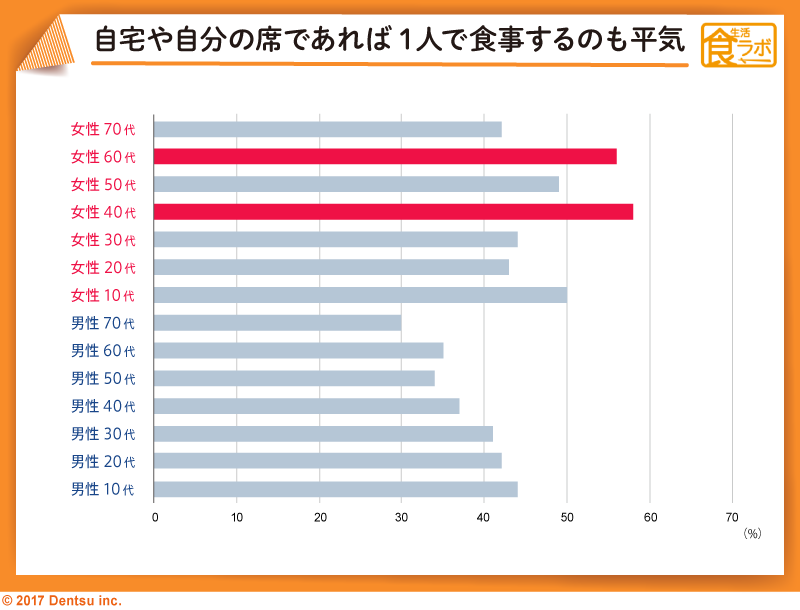
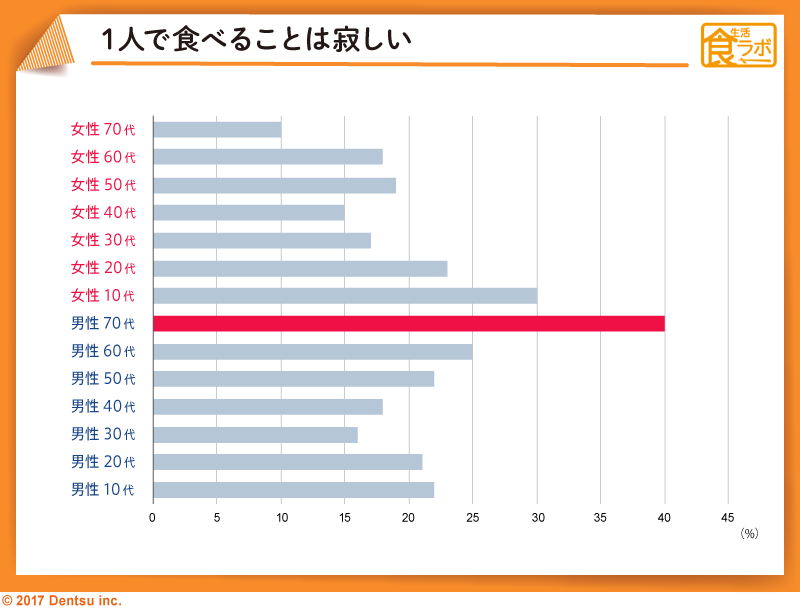
These results reveal that perceptions during solitary eating actually differ slightly by gender and age group.
Here are some notable findings:
◆ "I'd rather not be seen eating alone" was most prominent among younger generations, especially teenage girls.
◆ "Eating alone feels like a hassle" is most prominent among women, especially those in their 30s.
◆ "I'm fine eating alone at home or at my own seat" is high among women, especially those in their 40s and 60s.
◆ "Eating alone feels lonely" is most prominent among men in their 70s (while women in their 70s scored very low).
In other words, even though we use the term "solitary eating," the feelings behind it vary. To put it another way:
◆ Teenage women: "Shy type solitary eating" with strong feelings of embarrassment
◆ Women in their 30s: "SOS-type solitary eating" driven by a desire to be freed from the daily burden and hassle of meal preparation.
◆ Women in their 40s and 60s practice "enlightened solitary eating," accustomed to eating alone.
◆Men in their 70s: "Lonely-type solitary eating" where loneliness takes precedence
This seems to be the case.
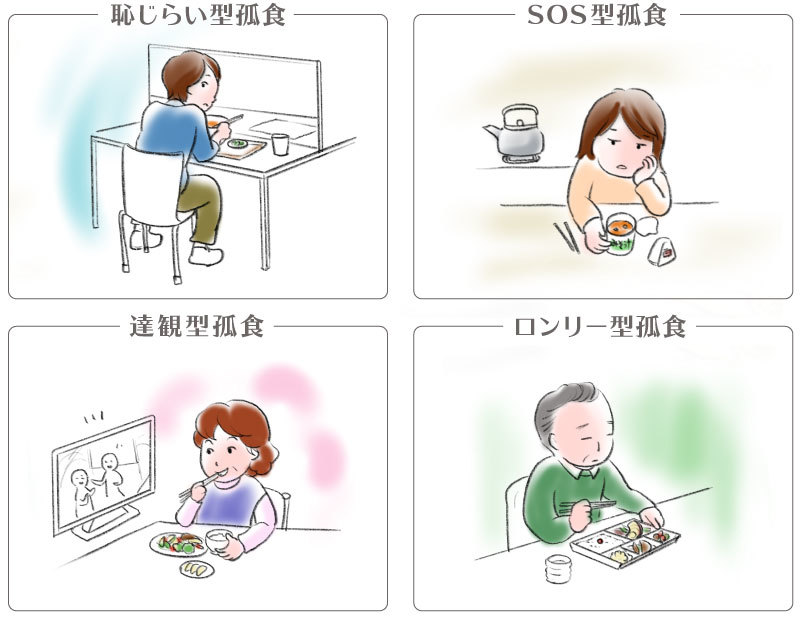
Illustration: Mio Oshima/Dentsu Inc.
While the survey results are categorized by demographic characteristics for convenience, these types may not be limited to specific genders or age groups.
Which type are you?
I'm... the SOS type (wry smile). Cooking meals every day is pretty tough, isn't it...
The Essence of Solo Dining Marketing
By not lumping solitary eating together but deliberately categorizing it like this, we start to see a little clearer how to move the hearts of these consumers.
For example, the "SOS-type solitary eater" who says, "Eating alone is just too much hassle."
For these people, we could propose a "reversal of hassle" concept: "Enjoy the ultimate hassle-free luxury when you're alone!" If, like Amazon Dash, a delicious-smelling lunch from your favorite restaurant arrived with just the press of a button, you wouldn't be able to complain about eating being a hassle, right?
For those experiencing "lonely solitary dining," we could propose solutions to alleviate loneliness.
Creating shared dining spaces with others who share common interests might be effective. For example, if there were themed izakayas for senior men, like ones focused on fishing or shogi, it could reduce the number of lonely solo dinners.
Thinking this way reveals that while we broadly call it solitary dining, the approach differs based on the underlying feelings behind it.
As single-person households increase in Japan, so will opportunities for solitary dining. In this context, solitary dining marketing will become increasingly important. Its true appeal lies in unraveling the insights behind each type of solitary dining and crafting proposals that genuinely resonate with each individual's experience.
Now, the theme for next time is "Food and SNS."
We'll explore these two phenomena, now inseparable in our modern era. Stay tuned!










